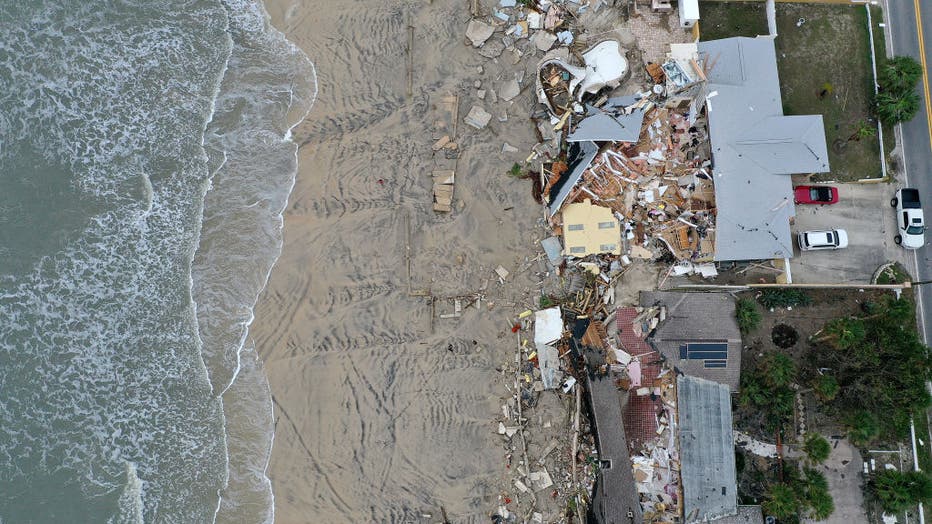Tracking Nicole: Tropical depression brings rain, winds as it heads through Georgia

Friday morning weather forecast
Metro Atlanta is getting a soggy start thanks to Tropical Depression Nicole with steady rain and gusty winds expected throughout the morning.
ATLANTA - After pummeling the entire state of Florida with strong winds and heavy rains, Tropical Depression Nicole has begun moving through Georgia Friday morning.
As of 4 a.m. Friday, Nicole's center was located about 70 miles southwest of Macon, Georgia and moving north-northwest at 16 mph. The storm is expected to move across central and northern Georgia over the morning and hit the western Carolinas later Friday afternoon.
A wind advisory is in effect across most of Georgia until 7 p.m. Friday with northeast winds potentially between 15 and 25 miles per hour. Gusts could reach up to 40 miles per hour. The intensity of the wind and direction will shift as the day progresses.

Tropical Depression Nicole bringing wind and rain as it moves through Georgia
Tropical Depression Nicole moved through Georgia Friday morning after a day of causing havoc as it churned through Florida as a hurricane and then a tropical storm.
The rare November hurricane could dump as much as 6 inches of rain over the Blue Ridge Mountains by Friday, the National Hurricane Center said. Flash and urban flooding will be possible as the rain spreads into the eastern Ohio Valley, Mid-Atlantic and New England through Saturday.
A spin-up tornado cannot be ruled out on Friday as the storm passes.
A handful of school districts in north Georgia have opted to adjust their schedules or close entirely.
Along the Georgia coast, utility workers and Red Cross volunteers positioned crews so that they will be ready to respond to any damage. Tree damage and power outages are possible in areas covered by the Wind Advisory.
As of 6 a.m., less than 2,000 customers total in Georgia were without power according to Georgia Power and the Georgia Electrical Membership Corp.
Nicole had spent Thursday cutting across central Florida after making landfall as a hurricane early that morning near Vero Beach. The brunt of the damage was along the East Coast well north of there, in the Daytona Beach area. The storm made it to the Gulf of Mexico on Thursday evening before turning north.
The storm caused at least two deaths and sent homes along Florida’s coast toppling into the Atlantic Ocean and damaged many others, including hotels and a row of high-rise condominiums. It was another devastating blow just weeks after Hurricane Ian came ashore on the Gulf Coast, killing more than 130 people and destroying thousands of homes.
Nicole was the first hurricane to hit the Bahamas since Hurricane Dorian, a Category 5 storm that devastated the archipelago in 2019. For storm-weary Floridians, it was only the first November hurricane to hit their shores since 1985 and only the third since recordkeeping began in 1853.
Nicole was sprawling, covering nearly the entire weather-weary state of Florida while also reaching into Georgia and the Carolinas before dawn on Thursday. Tropical storm-force winds extended as far as 450 miles from the center in some directions as Nicole turned northward over central Florida.
WATCH: BUILDING COLLAPSES AT DAYTONA BEACH SHORES AS TROPICAL STORM NICOLE APPROACHES
Officials in Volusia County, northeast of Orlando, said Thursday evening that building inspectors had declared 24 hotels and condos in Daytona Beach Shores and New Smyrna Beach to be unsafe and ordered their evacuations. At least 25 single-family homes in Wilbur-by-the-Sea had been declared structurally unsafe by building inspectors and also were evacuated, county officials said.
"Structural damage along our coastline is unprecedented. We’ve never experienced anything like this before," County Manager George Recktenwald said during a news conference earlier, noting that it was not known when evacuated residents can safely return home.

In this aerial view, homes are partially toppled onto the beach after Hurricane Nicole came ashore on November 10, 2022 in Daytona Beach, Florida. (Photo by Joe Raedle/Getty Images)
A man and a woman were killed by electrocution when they touched downed power lines in the Orlando area, the Orange County Sheriff’s Office said. Nicole also caused flooding well inland, as parts of the St. Johns River were at or above flood stage and some rivers in the Tampa Bay area also nearing flood levels, according to the National Weather Service.
All 67 Florida counties were under a state of emergency. President Joe Biden also approved an emergency declaration for the Seminole Tribe of Florida, ordering federal help for the tribal nation. Many Seminoles live on six reservations around the state.
Parts of Florida were devastated by Hurricane Ian, which struck as a Category 4 storm. Ian destroyed homes and damaged crops, including orange groves, across the state — damage that many are still dealing with — and sent a storm surge of up to 13 feet (4 meters) onshore, causing widespread destruction.
The Associated Press contributed to this report.

